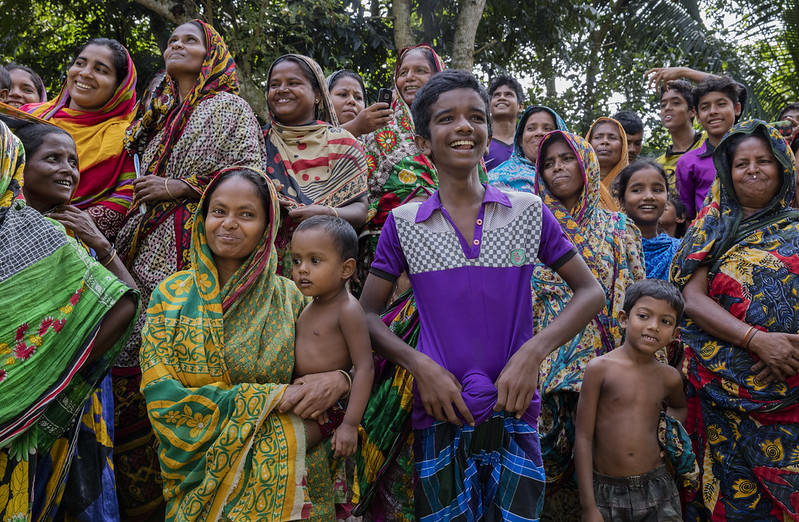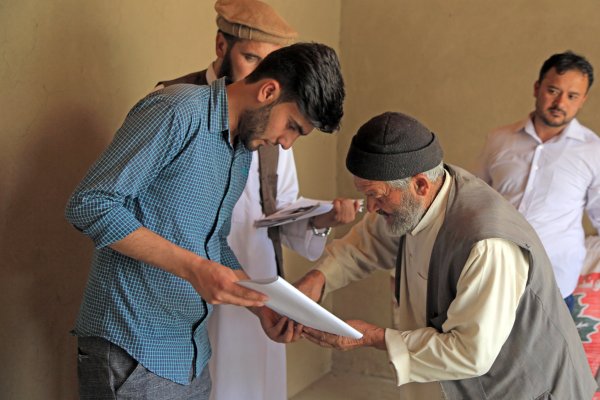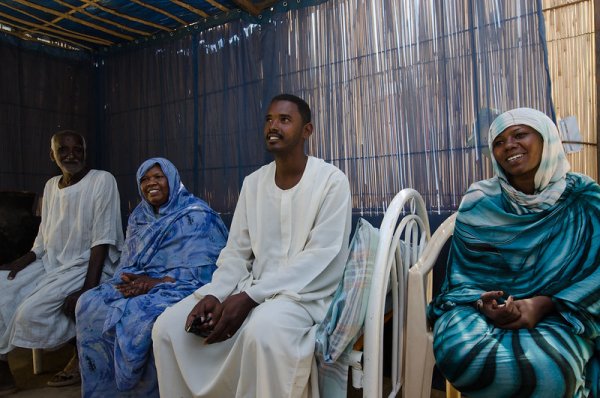IDDO’s team looks forward to sharing its latest research at ASTMH
Join IDDO and WWARN’s researchers at this year’s American Society of Tropical Medicine & Hygiene (ASTMH) in where we will be presenting on Visceral Leishmaniasis, malaria, COVID-19 and across symposia, oral presentations and posters.

Taking place in New Orleans, USA, this year IDDO will be at stand #104, as part of the Centre for Tropical Medicine and Global Health, University of Oxford. Come and see us to find out about more about our research, data platforms and latest work.
IDDO’s team is hosting a symposium titled: ‘Improving the diagnosis and management of severe malaria’. Taking place on Saturday, November 16, at 8am (CST), the symposium will be chaired by IDDO’s Associate Director Dr James Watson and Dr Elizabeth George, who heads up the WWARN Severe Malaria theme, with presentations by:
- Dr Peter Olumese (WHO) - The need to update WHO guidelines around severe malaria
- Dr Elizabeth George - Management of patients with severe malaria and the need for randomized trials in Africa
- Dr James Watson - Improving the diagnosis and triage of patients with suspected severe malaria
- Prof Sir Nick White - Pre-referral treatment for severe malaria
- Prof Arjen Dondorp - Pathophysiology of severe malaria: updates
- Prof Kamija Phiri - Post-discharge malaria chemoprevention: from policy to practice
IDDO’s talks include Dr James Wilson, who will talk about his work, ‘Peering into the Crystal Ball - Predicting Outcomes in Visceral Leishmaniasis, in Scientific Session 128: Clinical Tropical Medicine: Neglected Tropical Diseases’, on Saturday, November 16, at 12.45pm (CST).
While Dr Prabin Dahal will present his work, Severe Anaemia and Haemoglobin Trajectory following Treatment of Visceral Leishmaniasis: An Individual patient data meta-analysis using the Infectious Diseases Data Observatory Data Platform, in Scientific Session 168 on Sunday, November 17, at 8am (CST).
Our collaborators will also be presenting their work, look out for:
Professor Joel Tarning, head of WWARN Pharmacometric Modelling and Head of Clinical Pharmacology at MORU Bangkok, will present his latest work in symposium: Neglected tropical diseases: Getting the dose right, on Thursday Nov 14, from 10.15am (CST) in room 357.
PARMA Symposium #62, organised by the Malaria Branch, Centers for Disease Control & Prevention, titled Falling Dominoes: Antimalarial Resistance Proliferation in East and Central Africa. It takes place on Friday, November 15, from 10.15am (CST) at the Convention Center Hall I-2 (first floor)
Professor Joel Tarning will give a rapid oral talk on: Pharmacokinetic and Pharmacodynamic Modeling of Monthly Tafenoquine in Healthy Vietnamese Volunteers for Malaria Prophylaxis and Elimination on Friday Nov 15, from 10.15am (CST) in room 393/394. This will also be in poster session C on Saturday, November 16.
IDDO and WWARN’s researchers are also presenting a number of posters at ASTMH
Poster Session A: Thursday, November 14, Noon – 1:45 pm (CST)
- Professor Joel Tarning: Group Dose-optimisation of the fixed-dose triple combination antimalarial therapy artemether-lumefantrine-amodiaquine
- Professor Joel Tarning: Ivermectin and Anopheles Glutamate-Gated Chloride Ion Channel Interactions
- Professor Joel Tarning: Pre-referral rectal artesunate in children with severe malaria: any benefit?
- Poster Session B, Friday, November 15, Noon – 1:45 pm (CST)
- Professor Joel Tarning: Pharmacokinetic properties and mosquito-lethal effects of a novel long-lasting formulation of ivermectin in cattle
- Professor Joel Tarning: Population pharmacokinetics of artemether–lumefantrine plus amodiaquine in patients with uncomplicated Plasmodium falciparum malaria
Poster Session C, Saturday, November 16, 11 am – 12:45pm (CST)
- Dr Prabin Dahal: Factors associated with Relapse in Visceral Leishmaniasis: An Individual Patient Data Meta-Analysis using the Infectious Diseases Data Observatory Data Platform #8191
- Professor Joel Tarning: Pharmacokinetic and Pharmacodynamic Modeling of Monthly Tafenoquine in Healthy Vietnamese Volunteers for Malaria Prophylaxis and Elimination
- Dr Prabin Dahal: Exploring the Impact of Randomised Controlled Trials Evaluating COVID-19 Therapeutics on Clinical Practice Guidelines
ASTMH takes place from November 13 to 17, at the Ernest N. Morial Convention Center, New Orleans, where thousands of researchers, scientists, physicians and global health experts are expected to attend. For more information view https://www.astmh.org/
If you are not able to join us in-person then why not follow what is happening at the conference over Twitter by following us on @IDDOnews
Read our latest news or email info@iddo.org with your questions.
Development and validation of a prognostic model for visceral leishmaniasis relapse

In 2005, a WHO-supported Memorandum of Understanding was signed by the governments of Bangladesh, Nepal and India, confirming their commitment to the elimination of visceral leishmaniasis (VL) as a public health problem(1). Subsequent elimination efforts have led to a striking reduction in VL incidence in the Indian subcontinent (ISC), from over 50,000 reported cases in 2007 to 1,069 cases in 2022(2). Recent figures from India, once considered the most endemic country in the world for VL, report under 600 cases in 2023; down from approximately 900 cases in 2022(3). Among factors often cited for the campaign’s success include the lack of an established animal reservoir(4).
As elimination efforts transition to the post-validation phase, there is increasing focus on identifying and reducing infection reservoirs that persist following initial treatment success, including VL relapse and post-kala-azar dermal leishmaniasis (PKDL)(5). VL relapse cases are of particular public health concern due to the potential selection of parasites with increased infectivity(6) and drug resistance mutations(4). Defined as the recurrence of signs and symptoms of infection within 6 months of treatment and initial cure, VL relapse is frequently shown to be the most common cause of treatment failure in the ISC(7,8). Clinical efficacy studies evaluating the current first-line treatment of single-dose liposomal amphotericin B show relapse rates of approximately 3-4%(9), although this is likely an underestimate of the true relapse rate due to relatively healthy patients selected by restrictive inclusion criteria. Furthermore, a significant number of disease recurrences occur after 6-months of treatment(7,10).
Despite the importance of VL relapse both at the individual patient level and in the context of the elimination programme, relatively little is known about relapse risk factors in immunocompetent patients. In a recent update to the WHO Regional Strategic Framework for VL elimination, the diagnosis of relapse cases is recognised as a strategic priority, and that identifying relapse predictors represents a remaining gap in evidence(11).
To address this evidence gap, we intend to leverage individual patient data (IPD) from the IDDO VL data platform of clinical efficacy studies, to develop and internally validate a prognostic model predicting VL relapse in the ISC. We hope such a model can provide a useful bedside tool to identify patients at increased risk of relapse. Through stakeholder engagement, VL management guidelines could utilise such a model to target high-risk patients for intensive post-treatment follow-up.
- Develop a prognostic model predicting relapse for patients diagnosed with visceral leishmaniasis in the Indian subcontinent (ISC: India, Nepal, Bangladesh)
- Perform internal validation of the prognostic model (to account for model overfitting)
- Present the model such that it can be used as a bedside clinical tool (e.g. as a risk score)
We anticipate developing at least two prognostic models: one including parasite smear grade, and one without parasite smear grade. This reflects the fact that many patients in the ISC are diagnosed without microbiological confirmation.
All curated studies shared in the IDDO VL data platform meet the following criteria:
- Studies performed in the Indian subcontinent (India, Nepal, Bangladesh)
- Clinical efficacy studies that prospectively recruited patients with a diagnosis of visceral leishmaniasis (clinical symptoms with either parasitological or serological confirmation)
- Studies with treatment regimen available (at least drug(s) name, dose and duration)
- Studies with patient demographics available (at least age, sex)
- At least 6 months of active patient follow-up following initial treatment
- Studies reporting relapse (defined as new signs and/or symptoms of visceral leishmaniasis within 6 months of treatment completion in patients who achieved initial cure)
- Studies with patient signs and symptoms available (e.g. duration of fever, presence and magnitude of weight loss, splenomegaly, hepatomegaly, fever and other vital signs at baseline)
- Studies with blood and/or urine tests available (e.g. haemoglobin, renal function tests, liver function tests, platelet count, white blood cell count, pregnancy test)
- Microbiological investigations (e.g. splenic smear grade, bone marrow smear grade)
- Presence of a published study protocol and final manuscript
- Information on concomitant illness (e.g. malaria, tuberculosis, HIV)
All studies will be curated to the CDISC SDTM standard(12), adapted by IDDO for visceral leishmaniasis(13).
To meet the first objective, the outcome of relapse and important predictors (as described in the essential and desirable criteria above) will be identified in an exploratory analysis. A sample size calculation will guide the number of predictors such a model can support(14). A full protocol will then be published on PROSPERO.
We aim to account for clustering at the study level by using a random intercept model (multilevel model). Multiple imputations will be used to impute important missing predictors. Established guidelines for the development and validation of prediction models will be adhered to(15,16).
The study group consists of investigators who provide relevant studies for the pooled analysis, and investigators contributing statistical or disease-specific support. Together, the group decides on the inclusion of additional studies, data analysis, and publication plans, in accordance with the IDDO/WWARN Publication Policy(17).
For further information please contact Dr James Wilson (james.wilson@iddo.org).
1. World Health Organization. Regional Strategic Framework for Elimination of Kala-azar from the South-East Asia Region (2005 - 2015). [Internet]. Delhi: WHO Regional Office for South-East Asia; 2005 [cited 2024 Oct 7]. Available from: https://apps.who.int/iris/handle/10665/205825
2. World Health Organization. The Global Health Observatory: Number of cases of visceral leishmaniasis reported. [Internet]. [cited 2024 Oct 7]. Available from: https://www.who.int/data/gho/data/indicators/indicator-details/GHO/number-of-cases-of-visceral-leishmaniasis-reported
3. National Center for Vector Borne Diseases Control. Kala-azar Cases and Deaths in the Country since 2014 [Internet]. [cited 2024 Oct 22]. Available from: https://ncvbdc.mohfw.gov.in/index1.php?lang=1&level=2&sublinkid=5945&lid=3750
4. Singh OP, Singh B, Chakravarty J, Sundar S. Current challenges in treatment options for visceral leishmaniasis in India: a public health perspective. Infect Dis Poverty. 2016 Dec;5(1):19.
5. Hirve S, Boelaert M, Matlashewski G, Mondal D, Arana B, Kroeger A, et al. Transmission Dynamics of Visceral Leishmaniasis in the Indian Subcontinent – A Systematic Literature Review. Chatterjee M, editor. PLoS Negl Trop Dis. 2016 Aug 4;10(8):e0004896.
6. Rai K, Cuypers B, Bhattarai NR, Uranw S, Berg M, Ostyn B, et al. Relapse after treatment with miltefosine for visceral leishmaniasis is associated with increased infectivity of the infecting Leishmania donovani strain. mBio. 2013 Oct 8;4(5):e00611-00613.
7. Goyal V, Das VNR, Singh SN, Singh RS, Pandey K, Verma N, et al. Long-term incidence of relapse and post-kala-azar dermal leishmaniasis after three different visceral leishmaniasis treatment regimens in Bihar, India. Werneck GL, editor. PLoS Negl Trop Dis. 2020 Jul 20;14(7):e0008429.
8. World Health Organization. Report of Meeting of the Regional Technical Advisory Group (RTAG) on visceral leishmaniasis and the national visceral leishmaniasis programme managers of endemic member states. [Internet]. Regional Office for South-East Asia; 2020 [cited 2024 Oct 7]. Available from: https://iris.who.int/handle/10665/340612
9. Chhajed R, Dahal P, Singh-Phulgenda S, Brack M, Naylor C, Sundar S, et al. Estimating the proportion of relapse following treatment of Visceral Leishmaniasis: meta-analysis using Infectious Diseases Data Observatory (IDDO) systematic review. The Lancet Regional Health - Southeast Asia. 2024 Mar;22:100317.
10. Burza S, Sinha PK, Mahajan R, Lima MA, Mitra G, Verma N, et al. Risk factors for visceral leishmaniasis relapse in immunocompetent patients following treatment with 20 mg/kg liposomal amphotericin B (Ambisome) in Bihar, India. PLoS Negl Trop Dis. 2014;8(1):e2536.
11. World Health Organization. Regional strategic framework for accelerating and sustaining elimination of kala-azar in the South-East Asia Region, 2022-2026 [Internet]. New Delhi: World Health Organization, South-East Asian Region; 2022. Available from: https://iris.who.int/bitstream/handle/10665/361887/9789290209812-eng.pdf
12. Clinical Data Interchange Standards Consortium (CDISC). Study Data Tabulation Model (SDTM) [Internet]. [cited 2024 Oct 8]. Available from: https://www.cdisc.org/standards/foundational/sdtm
13. Infectious Diseases Data Observatory (IDDO). New global collaboration developing standards for standardised data collection across the VL research community [Internet]. 2020 [cited 2024 Oct 8]. Available from: https://www.iddo.org/news/new-global-collaboration-developing-standards-standardised-data-collection-across-vl-research
14. Riley RD, Snell KI, Ensor J, Burke DL, Harrell Jr FE, Moons KG, et al. Minimum sample size for developing a multivariable prediction model: PART II ‐ binary and time‐to‐event outcomes. Statistics in Medicine. 2019 Mar 30;38(7):1276–96.
15. Collins GS, Reitsma JB, Altman DG, Moons KGM. Transparent Reporting of a Multivariable Prediction Model for Individual Prognosis or Diagnosis (TRIPOD): The TRIPOD Statement. European Urology. 2015 Jun;67(6):1142–51.
16. Debray TPA, Collins GS, Riley RD, Snell KIE, Van Calster B, Reitsma JB, et al. Transparent reporting of multivariable prediction models developed or validated using clustered data (TRIPOD-Cluster): explanation and elaboration. BMJ. 2023 Feb 7;e071058.
17. Infectious Diseases Data Observatory (IDDO). IDDO/WWARN Policy on Data Use, Publication and Credit [Internet]. [cited 2024 Oct 8]. Available from: https://www.iddo.org/sites/default/files/2024-10/IDDO%20publication%20policy%20final2.pdf
Riley joined IDDO in September 2024. As a Data Manager, they work on the management and transformation of diverse data sets that are submitted to IDDO, as well as ensuring the completeness and accuracy of data in the IDDO data repository.
Prior to joining IDDO, they worked as a Data Wrangler for the Oxford-Novartis collaboration where they handled big data from IL-17A inhibitor clinical trials.
Riley holds a MBiol Microbiology/Biotechnology from the University of York and a MSc Data Science from Loughborough University.

Forhad is a Bangladeshi consultant in medicine with a deep passion for sepsis, antimicrobial resistance (AMR), and conducting high-quality clinical trials in low-resource settings. He has been serving in the Bangladesh Civil Service since 2010, demonstrating a strong commitment to public health and clinical excellence. Forhad is a Commonwealth Scholar who was featured in the Yearbook 21 of the Commonwealth Scholarship Commission, UK. In recognition of his exceptional contributions during the COVID-19 pandemic, he received the prestigious Integrity Award 2021 from the Government of Bangladesh.
Forhad has co-authored the National Guidelines on Clinical Management of COVID-19 and the Standard Treatment Guidelines of Common Infections of Bangladesh, contributing significantly to national healthcare protocols. He also serves as a guest lecturer at the Liverpool School of Tropical Medicine, UK, where he shares his expertise with the next generation of healthcare professionals.
Currently, Forhad is conducting a systematic review to estimate the burden of AMR in Bangladesh in collaboration with Prof. Philippe Guerin at the Infectious Diseases Data Observatory (IDDO). He is also leading a randomized controlled trial to investigate the role of procalcitonin in reducing antibiotic therapy in adult sepsis patients under the supervision of Prof. Arjen Dondorp. Forhad’s work is driven by his dedication to improving healthcare standards and outcomes in resource-limited settings through rigorous research and clinical innovation.
Design, Conduct, Analysis, and Reporting of Therapeutic Efficacy Studies in Visceral Leishmaniasis: A Systematic Review of Published Reports, 2000–2021
A systematic review (SR) of published efficacy studies in visceral leishmaniasis (VL) was undertaken to describe methodological aspects of design, conduct, analysis, and reporting. Studies published during 2000–2021 and indexed in the Infectious Diseases Data Observatory VL library of clinical studies were eligible for inclusion (N = 89 studies). Of the 89 studies, 40 (44.9%) were randomized, 33 (37.1%) were single-armed, 14 (15.7%) were nonrandomized multiarmed studies, and randomization status was unclear in two (2.2%). After initial screening, disease confirmation was done by microscopy in 26 (29.2%) and by a combination of serology and microscopy in 63 (70.8%). Post-treatment follow-up duration was <6 months in three (3.3%) studies, 6 months in 75 (84.3%), and >6 months in 11 (12.4%) studies. Confirmation of relapse was solely based on clinical suspicion in four (4.5%) studies, parasitological demonstration in 64 (71.9%), using molecular/serological/parasitological method in 6 (6.7%), and there was no information in 15 (16.9%). Of the 40 randomized studies, sample size calculation was reported in only 22 (55.0%) studies. This review highlights substantial variations in definitions adopted for disease diagnosis and therapeutic outcomes suggesting a need for a harmonized trials protocol.
Review summarises heterogeneity in design and analysis of visceral leishmaniasis clinical trials
A new systematic review, published in the American Journal of Tropical Medicine & Hygiene, summarises the heterogeneity in design and analysis of clinical trials for visceral leishmaniasis (VL) – information which can potentially help improve future trial designs.

Visceral leishmaniasis (VL) is a neglected tropical disease that is transmitted by female sandflies. VL is the most severe of the three forms of leishmaniasis and is almost always fatal without treatment. The World Health Organization (WHO) estimates there are between 50,000 to 90,000 new cases worldwide every year.
The review based on the Infectious Diseases Data Observatory (IDDO) VL library of published efficacy studies, described methodological aspect of design, conduct, analysis, and reporting from 89 studies published during 2000-2021.
The review highlighted substantial variations in definitions adopted for patient screening, disease diagnosis and therapeutic outcomes along with variability in inclusion and exclusion criteria adopted for patient enrolment.
One of the study authors Prabin Dahal said: “By studying existing literature, gaps in knowledge can be identified and research can be targeted at specific patient populations. For example, our review identified that patients with severe malnutrition or pregnant women were excluded in vast majority of the trials, highlighting limited evidence regarding treatment efficacy in this patient population.”
Prof Ahmed Musa, a globally recognised expert on Visceral Leishmaniasis clinical trials design and conduct from the University of Khartoum, Sudan, stated: “This review is timely and provides a comprehensive overview of the existing methodological practices in VL trials from the literature. This can serve as a useful source of information regarding different aspects of trial to inform future designs. This is particularly important to maximise existing resources as undertaking randomised trials for novel drug regimens in VL remains a major challenge due to financial constraints and operational difficulties.”
Read the full paper: ‘Design, conduct, analysis, and reporting of therapeutic efficacy studies in Visceral Leishmaniasis: A systematic review of published reports, 2000-2021’
Blood transfusion in the care of patients with visceral leishmaniasis: a review of practices in therapeutic efficacy studies
Abstract
Blood transfusion remains an important aspect of patient management in visceral leishmaniasis (VL). However, transfusion triggers considered are poorly understood. This review summarises the transfusion practices adopted in VL efficacy studies using the Infectious Diseases Data Observatory VL clinical trials library. Of the 160 studies (1980–2021) indexed in the IDDO VL library, description of blood transfusion was presented in 16 (10.0%) (n=3459 patients) studies. Transfusion was initiated solely based on haemoglobin (Hb) measurement in nine studies, combining Hb measurement with an additional condition (epistaxis/poor health/clinical instability) in three studies and the criteria was not mentioned in four studies. The Hb threshold range for triggering transfusion was 3–8 g/dL. The number of patients receiving transfusion was explicitly reported in 10 studies (2421 patients enrolled, 217 underwent transfusion). The median proportion of patients who received transfusion in a study was 8.0% (Interquartile range: 4.7% to 47.2%; range: 0–100%; n=10 studies). Of the 217 patients requiring transfusion, 58 occurred before VL treatment initiation, 46 during the treatment/follow-up phase and the time was not mentioned in 113. This review describes the variation in clinical practice and is an important initial step in policy/guideline development, where both the patient's Hb concentration and clinical status must be considered.
Analysis provides evidence of research gaps on the risk-benefit of blood transfusion in Visceral Leishmaniasis patients
A new review summarises existing evidence gaps regarding when blood transfusions should be carried out for visceral leishmaniasis patients. The review is published in Transactions of the Royal Society of Tropical Medicine and Hygiene.

Visceral leishmaniasis (VL) is the most severe of the three forms of leishmaniasis and is fatal without treatment. A blood transfusion is an important aspect of patient management but currently the trigger to carry out the procedure is poorly understood.
The 2010 World Health Organization (WHO) technical report on leishmaniasis suggests undertaking transfusion in patients with severe anaemia. Transfusion may also be indicated in cases of acute blood loss due to invasive procedures such as splenic aspiration. Despite the importance of transfusion in the management of VL patients, the actual practice in clinical trials is poorly reported and remains largely unclear.
Researchers used the IDDO VL clinical trials library and accessed 160 studies between 1980–2021. A total of 16 studies, with 3,459 patients, included a description of blood transfusion. The review found the number of patients receiving a transfusion was explicitly reported in only 10 studies and of the 2,421 patients enrolled, 217 underwent transfusion. Of the 217 patients, for 58, transfusion occurred before the start of treatment for VL, in 46 it was during the treatment/follow-up phase, and for 113 patients the time was not mentioned.
Transfusion was initiated solely based on haemoglobin (Hb) measurement in nine studies, combining Hb measurement with an additional condition (epistaxis/poor health/clinical instability) in three studies, and the criteria was not mentioned in four studies. Hb threshold range for triggering transfusion was 3-8 g/dL.
One of the study authors Dr Prabin Dahal said: “We found data regarding blood transfusion in the treatment of VL remains largely unreported. In particular, the risk-benefit of transfusion practices in VL case management couldn’t be gauged from existing studies. Our research demonstrates the need for the research community to adopt a standardised methodology to generate and report transfusion related data. This type of data could help in assessing the impact of transfusion triggers on treatment outcomes.”
Prof Ahmed Musa, a globally recognised expert on visceral leishmaniasis from the University of Khartoum, Sudan said: “Patients with VL who require blood transfusion have low concentrations of cellular blood elements mainly red blood cells and plasma proteins including clotting factors. So, they commonly present with high-output heart failure or pending failure, bleeding and peripheral oedema due to low oncotic pressure of the blood and fatigue due to low oxygen tension at the tissue level leading to metabolic acidosis. Blood transfusion prevents the above-mentioned complications and can possibly accelerate the cure of visceral leishmaniasis. The selection of patients for blood transfusion is critical and should not depend on the level of haemoglobin only. This is because some patients adapt with low haemoglobin levels. This review provides an important evidence towards the need for incorporating clinical parameters as a part of transfusion trigger”.
Read the full paper Blood transfusion in the care of patients with visceral leishmaniasis: a review of practices in therapeutic efficacy studies
Scoping review suggests that PKDL data platform is feasible

A new systematic scoping review of post-kala-azar dermal leishmaniasis (PKDL) studies found 56 studies published since 1973, with more than half of the studies dating from the last decade. Based on the relatively recent studies, which together include nearly 2,500 patients, the authors believe that the establishment of a PKDL data platform is feasible. The study is published in PLoS Neglected Tropical Diseases.
PKDL is a dermatosis that can happen after successful visceral leishmaniasis (VL) treatment, manifesting in skin rashes that can be a reservoir of infection via sandfly vectors.
PKDL is therefore a public health problem, because it means that patients otherwise successfully treated for visceral leishmaniasis can still transmit the disease. Current PKDL treatments are either expensive, need to be taken for a long time, and/or have safety concerns.
“There are still a lot of gaps in current scientific knowledge of PKDL, including its pathophysiology and risk factors that can affect treatment outcome,” said the study’s corresponding author Dr Krishna Pandey, Director of the Indian Council of Medical Research-Rajendra memorial Research Institute of Medical Sciences (ICMR-RMRIMS).
IDDO already hosts an established VL data platform, and Dr Pandey is also a member of the Visceral Leishmaniasis scientific advisory board at IDDO. This IDDO data platform has a critical mass of data from VL clinical trials conducted over the past 20 years.
Dr Rishikesh Kumar, also from ICMR-RMRIMS and joint first author of the study, said, “Based on the number of studies we have identified in this review, we think that establishing a similar platform for PKDL is feasible, and will help address key knowledge gaps in PKDL.”
“Creating such a platform will enable in-depth individual patient data analyses, enabling researchers to address new research questions from existing data,” added Dr Prabin Dahal, study author and statistics lead IDDO.
The researchers calculated that if the number of patients from non-randomised studies were pooled, an individual patient data platform would have a large set of data from studies exploring the efficacy and safety of the three main medications used for PKDL.
“With the help of the global PKDL community and the right funding, we do think that a PKDL platform can be realised,” added IDDO’s Dr Sauman Singh, the paper’s first and corresponding author.
“This will allow a nuanced exploration of the safety and efficacy of PKDL drugs which can ultimately produce better treatments for patients,” said Professor Philippe Guerin, the review’s principal investigator and IDDO Director.
Post-kala-azar dermal leishmaniasis (PKDL) drug efficacy study landscape: A systematic scoping review of clinical trials and observational studies to assess the feasibility of establishing an individual participant-level data (IPD) platform
Abstract
Background
Post-kala-azar dermal leishmaniasis (PKDL) is a dermatosis which can occur after successful treatment of visceral leishmaniasis (VL) and is a public health problem in VL endemic areas. We conducted a systematic scoping review to assess the characteristics of published PKDL clinical studies, understand the scope of research and explore the feasibility and value of developing a PKDL individual patient data (IPD) platform.
Methods
A systematic review of published literature was conducted to identify PKDL clinical studies by searching the following databases: PubMed, Scopus, Ovid Embase, Web of Science Core Collection, WHO Global Index Medicus, PASCAL, Clinicaltrials.gov, Ovid Global Health, Cochrane Database and CENTRAL, and the WHO International Clinical Trials Registry Platform. Only prospective studies in humans with PKDL diagnosis, treatment, and follow-up measurements between January 1973 and March 2023 were included. Extracted data includes variables on patient characteristics, treatment regimens, diagnostic methods, geographical locations, efficacy endpoints, adverse events and statistical methodology.
Results
A total of 3,418 records were screened, of which 56 unique studies (n = 2,486 patients) were included in this review. Out of the 56 studies, 36 (64.3%) were from India (1983–2022), 12 (21.4%) from Sudan (1992–2021), 6 (10.7%) were from Bangladesh (1991–2019), and 2 (3.6%) from Nepal (2001–2007). Five (8.9%) studies were published between 1981–1990 (n = 193 patients), 10 (17.9%) between 1991–2000 (n = 230 patients), 10 (17.9%) between 2001–2010 (n = 198 patients), and 31 (55.4%) from 2011 onwards (n = 1,865 patients). Eight (14.3%) were randomised clinical trials, and 48 (85.7%) were non-randomised studies. The median post-treatment follow-up duration was 365 days (range: 90–540 days) in 8 RCTs and 360 days (range: 28–2,373 days) in 48 non-randomised studies. Disease diagnosis was based on clinical criterion in 3 (5.4%) studies, a mixture of clinical and parasitological methods in 47 (83.9%) and was unclear in 6 (10.7%) studies. Major drugs used for treatment were miltefosine (n = 636 patients), liposomal amphotericin B (L-AmB) (n = 508 patients), and antinomy regimens (n = 454 patients). Ten other drug regimens were tested in 270 patients with less than 60 patients per regimen.
Conclusions
Our review identified studies with very limited sample size for the three major drugs (miltefosine, L-AmB, and pentavalent antimony), while the number of patients combined across studies suggest that the IPD platform would be valuable. With the support of relevant stakeholders, the global PKDL community and sufficient financing, a PKDL IPD platform can be realised. This will allow for exploration of different aspects of treatment safety and efficacy, which can potentially guide future healthcare decisions and clinical practices.





